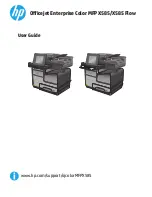
4
Operator’s Manual
The El Diablo HE truck mount unit must be securely
bolted through the floor of the vehicle in which it is
installed. Serious damage to the equipment or personal
injury may occur if the machine is not mounted properly.
The El Diablo HE truck mount weighs approximately
700lbs. The use of a forklift is required when lifting the machine
into a vehicle. It is also strongly recommended that a second
person be utilized to stabilize the machine while it is on the fork-
lift, due to the center of gravity being heavy to the waste tank
side of the machine. Use caution when moving the machine
with the forklift to avoid damage to equipment, the vehicle
and personal injury.
The El Diablo HE truck mount can be installed into a ½ ton
or larger van; however, it is strongly recommended that it be
installed into a ¾ ton or larger van. The machine can be
installed in either the side door or rear door of the van. If the
machine is installed into the rear doors a vacuum hose reel may
be installed next to the machine to maximize van floor space
(See page 19).
Due to irregularities in the van floor it is suggested that
wood be placed under the machine to provide a level surface on
which the machine is mounted. The wood should be ½ “or ¾”
exterior grade plywood or equivalent.
The El Diablo HE has 2 “L” - shaped mounting brackets on
the front of the machine and holes pre-drilled into the rear of the
water box support on the back of the machine to be used for
mounting. There are also mounting tabs on the base of the
waste tank that can be used if the situation permits.
Before drilling holes in the van floor, check to ensure
that underneath the van floor there are no fuel lines, brake
lines, or other obstructions that could cause a safety haz-
ard. Use 3/8” bolts to secure the machine to the van floor. Lock
washers and large fender washers are recommended to be used
underneath the van. Tighten the bolts until the machine is
securely mounted to the floor.
The engine on the El Diablo HE runs on gasoline, there-
fore, it is recommended that the vehicle’s gasoline fuel tank be
accessed. There are several fuel tank hook-up kits available
from your supplier for each specific model of vehicle. It is rec-
ommended that the fuel hook-up kit be installed by only
qualified mechanics familiar with this type of modification.
If the equipment is to be installed into a trailer, make sure
that the fuel is stored in a proper tank and connected to the
machine according to federal, state and local regulations.
Installation
Operating Procedures
NOTE:
It is strongly recommended that a water soft-
ening system be used. It is highly likely that the water
in your area is considered hard. Hard water is water
that has a high mineral content. Your local water sup-
ply can be tested to determine the hardness. If the
water hardness is determined to be greater that 3.5
grains, a water softening system should be used.
Continued and prolonged use of the machine with
hard water will cause excessive scale buildup that
reduces heating and water flow performance. Hard
water also detracts from the performance and effec-
tiveness of the cleaning solutions.
Check oil levels
Make sure that the engine oil level is in the operating range
of the dipstick. Inspect the oil sight gauges on the Cat Pump and
the Roots blower to insure correct level of oil. Operating the
equipment with improper oil levels can cause damage to the com-
ponents that is not covered under warranty. (See the
Maintenance section for the proper oil to be used in the engine,
blower, and the pump.)
Check fuel levels
Make sure that there is an adequate supply of gasoline in
the gas tank to finish the job. If you are connected to the gaso-
line tank of the van, it is suggested that the level of fuel be no
less than ½ tank to avoid running the van out of fuel and being
stranded.





































